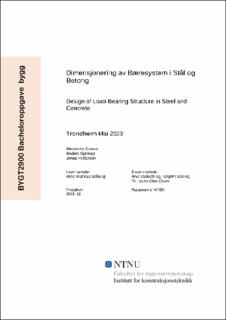| dc.contributor.advisor | Selberg, Arne Mathias | |
| dc.contributor.advisor | Soleng, Torgrim | |
| dc.contributor.advisor | Dalseth, Arve | |
| dc.contributor.author | Grasto, Alexanders | |
| dc.contributor.author | Gjelstad, Anders | |
| dc.contributor.author | Pettersen, Jonas | |
| dc.date.accessioned | 2023-07-13T17:20:10Z | |
| dc.date.available | 2023-07-13T17:20:10Z | |
| dc.date.issued | 2023 | |
| dc.identifier | no.ntnu:inspera:146719958:71113282 | |
| dc.identifier.uri | https://hdl.handle.net/11250/3078719 | |
| dc.description.abstract | Bacheloroppgaven tar for seg en produksjonshall for emballasje på Jøsnøya og er i regi Dr.techn. Olav Olsen, heretter O.O. Plasseringen av bygget er i et svært værutsatt kystområde. Prosjektet inkluderer beregninger av belastninger som bygningen utsettes for, global stabilitet, avstivende systemer og dimensjonering av hovedkomponentene i bæresystemet. Det er også undersøkt om prosjektet kunne blitt gjennomført på en enklere måte basert på konstruksjonstekniske hensyn. Omfanget av oppgaven er begrenset for å være i tråd med kravene til en bacheloroppgave. Metodikken og dimensjoneringen i oppgaven er derfor primært rettet mot studentenes ønske om utvikling av ferdigheter. Hovedmålet er å dimensjonere et bæresystem i stål og betong.
Det har blitt benyttet tilnærminger og forenklede beregningsmodeller for å representere konstruksjonens mekaniske atferd og lastscenarioer så nøyaktig som mulig. Fokus har vært på å sikre at disse modellene er realistiske og representative for den faktiske konstruksjonen.
Resultatene viser at fundament og ringmur kan utformes med slankere dimensjoner ved å inkludere flere vindkryss og sentrere søyler over ringmur. Flere vindkryss fører til en gunstigere fordeling av ytre krefter som virker på bygningen, og fører dem mer effektivt ned i fundamentet. Videre har det blitt påvist at det er mulig å unngå implementeringen av et komplekst sekundært bæresystem ved å bruke brannseksjoneringsvegger i plasstøpt betong i stedet for prefabrikkerte elementer.
I den avsluttende delen av oppgaven diskuteres de ulike valgene som er tatt og fordelene med de valgte utformingene. Alternative løsninger vurderes også, sammen med deres potensielle innvirkning på prosjektet. Oppgaven adresserer også forenklinger som er gjort og usikkerheten knyttet til disse. Bruken av analyseverktøy har gitt innsikt i hvordan den globale mekaniske atferden til bygningen påvirkes av ulike geometriske konfigurasjoner, inkludert laster på fundamentet og horisontal likevekt. Siden det er flere mulige tilnærminger for utformingen av konstruksjonen, er det ingen definitive svar. Ved å sammenligne ulike designalternativer og benytte resultater fra O.O., oppnås en dypere forståelse. | |
| dc.description.abstract | This bachelor thesis concerns a production facility for packaging on Jøsnøya, where Dr.techn. Olav Olsen designed the structural engineering. The building is located in a windy coastal area. The project includes calculations of the loads the structure is exposed to, global stability-analysis, design of bracing systems, and dimensioning of the main components of the load-bearing structures. A study has been conducted to determine whether the project could be executed in a simpler manner based on construction engineering considerations. The scope of the project was constrained; the workload was limited to that of a bachelor’s thesis. Consequently, the methodology and dimensioning primarily reflect the skills that the students want to develop. Hence, the task is to dimension a load-bearing system using steel and concrete.
Thus far, approximations and simplified calculation models have been employed to accurately represent the mechanical behavior and load scenarios of the load-bearing elements. Emphasis has been placed on ensuring that these models are as realistic and representative as possible.
The results indicate that the foundation and ring wall can be designed to be more slender by incorporating additional wind braces and aligning columns directly over the ring wall. This will result in a more favorable distribution of external forces acting upon the structure, effectively transferring them downward into the foundation. Furthermore, it has been proved that the implementation of a complex secondary load-bearing system can be avoided by introducing fireseparating walls in cast-in-place concrete instead of utilizing prefabricated elements.
The final section of the thesis discusses the various choices made throughout the project and highlights the advantages of the selected designs. Additionally, alternative solutions are considered, along with their potential impact on the project. The thesis addresses the simplifications made and the associated uncertainties. The utilization of analysis tools has provided insight into how the global mechanical behavior of the structure is affected by different geometric configurations, with the resulting loads on the foundation and horizontal equilibrium. As there are multiple viable approaches to the design of the structure, definitive answers are elusive. By comparing various design options and benchmarking against Dr.techn. Olav Olsen’s results, a deeper understanding has been achieved. | |
| dc.language | nob | |
| dc.publisher | NTNU | |
| dc.title | Dimensjonering av Bæresystem i Stål og Betong | |
| dc.type | Bachelor thesis | |
